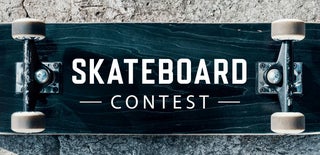Introduction: Tinkercad Custom Skateboard Headlight (No Skateboard Modifications)
Whether you are heading home after work, taking an evening skate, or heading to your friends house, it is important to see what is in front of you. For safety purposes, I believe that every skateboard should have a headlight on it for two main reasons:
1. Just as car headlights let you see what is in front of you in the dark, a skateboard headlight could reveal a stick, big crack in the sidewalk, or perhaps even an animal. This extra 5-10 feet of illumination (depending on strength of light) could really make the difference between safety and a crash.
2. Especially near the road if it is poorly lit, a skateboard headlight is a key factor to let a driver know that a skater is around. While this is NOT the primary focus, it is a benefit because we all could forget to wear bright clothes every once and a while.
The Great thing about this headlight is it doesn't require modifications to our beloved skateboard!
Supplies
• High Power Flashlight
• Tinkercad CAD software - if you don't have this, it is free and online here.
• Skateboard (obviously)
• High Strength Velcro (this can be found at a local hardware store)
• Digital Calipers/Ruler
Step 1: How to Make the Mount Fit for Your Skateboard and Flashlight on Tinkercad
The next few steps will be explaining how to use Tinkercad to custom fit your 3D printed flashlight mount on the skateboard as well as securely hold the flashlight. If you are already experienced in Tinkercad and know how to size the mount properly, feel free to skip to the filament optimization step!
Step 2: Basic Measurements on Skateboard Size
Take the length of the flashlight and record the measurement. Next, take the measurement you just wrote down, and from the tip of the skateboard put a second ruler perpendicular/make the point on the skateboard then flip the ruler 90 degrees and record the width.
Step 3: Measurements Part 2
Now in order to make the flashlight a press fit, take digital calipers and measure the diameter of the flashlight, along with the length the "grip" of the flashlight. Make sure to label which is which during recording.
Step 4: Turning Numbers Into Shapes
Take the blue semi-circle and drag in onto your workspace. Use two fingers to look directly onto the shape from above, and hold shift with two fingers on Mac, or the left clicker on a mouse to go forward/right/left/backwards. Click one of the corner squares and type the measurements for the skateboard into the boxes. After clicking, the blue box should highlight to indicate it is about to be edited. Also edit the height to 1/8 inch thick or thicker for the stable base.
Step 5: Press Fit Flashlight Mount in CAD
This is going to be the most complicated step because you have to get the curves vertical enough for a printer to handle them without supports and compensate for the printer causing the filament to slightly expand.
Part 1: Drag a orange cylinder onto the plane and rotate 90 degrees using the double arrow rotate tool. Make all the cylinders about 1/8 inch thick in EVERY DIRECTION then your flashlight measurements. Duplicate the cylinder and make it a hole. Size the "hole cylinder" to the flashlight sizes with about +.02 added in every direction so that it is not too tight.
Part 2: Center and group the cylinder and cylinder hole. Drag the newly created shape to tip of design and center it.
Step 6: Filament Efficiency
Save your filament and print quicker in this step by taking 3 inches off the opposite part of the tip using a rectangle hole. The width and height just need to be larger than the shape, no specific size.
Step 7: Press Fit Flashlight After Printing
It is important the while the print is still hot, instantly slide the flashlight it so that the print can cool around the flashlight. This will not mean that the flashlight can't be used anymore, it just will help mold the shape while the print is still slightly flexible.
Step 8: Velcro
Put velcro on and stick to board. This way it can be removed if you did not print with a water-ok filament. For more permanent implications, use loctite or super glue.
Step 9: Enjoy and Test!
Any questions and I will be happy to answer, about the build or for Tinkercad!

Participated in the
Skateboard Contest











